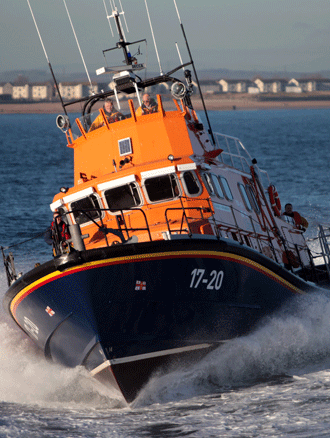April
Design boost for lifeboats

The approach to the design of all-weather lifeboats is set for a re-evaluation as part of a major study being led by Newcastle University and the RNLI, with support from Lloyds’ Register.
Set up to explore how new technology, materials and approaches can be used to improve the design, operation and maintenance practice of the RNLI’s Severn Class lifeboat, the four-year project will help to improve the performance of the craft while providing the safest possible environment for the RNLI’s volunteer crews.
Using computer models, small scale experiments and full-size trials to analyse the behaviour of lifeboats at a range of speeds and in varying conditions, the findings will inform new design specifications around speed, safety and efficiency.
Richard Birmingham, Professor of Small Craft Design in Newcastle University’s School of Marine Science and Technology and the Principal Investigator on the project, explained:
“The ability to safely perform at high speed and in extreme conditions is not only imperative for the safety of the volunteer crew but also has a direct effect on the efficiency and reliability of the search and rescue service.
“Designing a boat that is capable of travelling safely at greater speed and under the most extreme conditions, means a better response to emergency call-outs and less transit time to reach the casualty.”
Project lead Federico Prini (pictured), research associate at Newcastle University’s School of Marine Science and Technology, adds:
“When the RNLI’s lifeboats travel at speed and in rough seas, they can be subject to frequent and significant slamming as the boat crashes against the waves.
“Measuring these forces and the resulting impact on the vessel is crucial in order to design a craft that is capable of withstanding the loads experienced during rescue operations. That is what we are setting out to do – using the latest technology and equipment here at Newcastle University.”
Re-designing the lifeboat
The first dedicated lifeboat dates back to 1786, when the London coachbuilder Lionel Lukin was commissioned by the Duke of Northumberland to convert a coble – a North East Coast fishing craft – into an “unimmergible” lifeboat for beach rescue service at Bamburgh.
In 1789 The Adventure ran aground at the mouth of the Tyne when a violent storm hit the East coast.
The sea was too rough for the local men and their boats and they stood by helplessly as the entire crew of the Adventure drowned. Appalled by the loss of life, the Gentlemen of Law House sponsored the Design of a Boat for Saving Life from Shipwreck. The first purpose-built lifeboat was named “The Original” and was in service at the mouth of the River Tyne for some 40 years. Lifeboats remained substantially the same until the South Shields disaster of 1849, which saw the loss of the South Shields lifeboat together with twenty pilots.
Responding to the tragedy, in 1851 the then Duke of Northumberland sponsored a competition to re-design the lifeboat. The result was the introduction of the first self-righting lifeboats.
Today, the all-weather lifeboats employed by the RNLI are still expected to perform in the most extreme conditions, With a range of 100 nautical miles from the coast.
Restrictions to the allowable speed for a given sea state are due to the balancing requirements of optimum weight and structural strength together with the available propulsive power, the equipment functionality and the crew endurance and safety. The project seeks to provide a set of guidelines embedding all these limiting criteria. Guidelines that will be tailored to the needs of the RNLI’s design team as well as those of lifeboat operators and maintainers.
Holly Phillips, Principal Naval Architect at the RNLI, said:
“The ability of the crew to operate safely and efficiently has always been one of our major design drivers. We expect that the design improvements will contribute to increase the performance of the crafts as well as the safety of our crews.”
The RNLI is the charity that exists to save lives at sea. It provides a 24-hour lifeboat search and rescue service and seasonal lifeguard service around the United Kingdom and the Republic of Ireland. It has an active fleet of over 340 lifeboats, ranging from 3.8–17m in length.
The study is also supported by Lloyds’ Register (Marine), a leading global maritime classification society and engineering consultancy provider. They will bring some of that experience to the table, as a third party adviser and peer reviewer, and assisting the team draw up new guidelines.
Jesus Mediavilla Varas, Lead Specialist at LR’s Strategic Research and Technology Policy Group, added:
“Lloyd’s Register has been committed to improving the safety standards of operation of vessels at sea for more than 250 years. This project will help to de-risk the operation of lifeboats, by improving the current knowledge, and potentially contribute to further improve our special craft rules.”
published on: 8 April 2015
